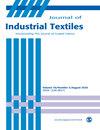Experimental study on protective performance of ACF sandwich composites with different configurations in high-velocity impact
IF 2
4区 工程技术
Q1 MATERIALS SCIENCE, TEXTILES
引用次数: 0
Abstract
The design of impact protective gear is crucial to human safety against high-velocity impacts from explosions. The rigid and flexible foam sandwich composites with ACF foam as the core and fiber-reinforced composite panels or high-performance fabrics as front/back panel materials were selected in this study. Hopkinson pressure bar experiment was conducted to assess the dynamic response, energy absorption, and dissipation rates of two types of composites in high-velocity impact. The effects of the number of structural layers, front/back panel thickness gradient, and panel material type on the protective performance were examined. The results demonstrated that the three-layer structure presented better protection and increased the energy absorption rate by 5% compared to the five-layer configuration in rigid and flexible composites. Thickness gradient and material type of panels had minimal impact on the protective performance of rigid composites compared to structural layers. Adding Kevlar layers to flexible composites improved protection, with 95.89% energy absorption and 31.82% energy dissipation at a core thickness of 8 mm. These insights guide the development of advanced impact protection materials to elevate personnel safety against high-velocity impacts.不同结构的 ACF 夹层复合材料在高速撞击中的防护性能实验研究
冲击防护装备的设计对于人类抵御爆炸产生的高速冲击的安全至关重要。本研究选择了以 ACF 泡沫为芯材,以纤维增强复合板或高性能织物为前后面板材料的刚性和柔性泡沫夹层复合材料。霍普金森压杆实验评估了两种复合材料在高速冲击下的动态响应、能量吸收和耗散率。研究了结构层数、前后面板厚度梯度和面板材料类型对防护性能的影响。结果表明,与五层结构的刚性和柔性复合材料相比,三层结构的保护性能更好,能量吸收率提高了 5%。与结构层相比,面板的厚度梯度和材料类型对刚性复合材料保护性能的影响最小。在柔性复合材料中添加凯夫拉纤维层提高了保护性能,在核心厚度为 8 毫米时,能量吸收率为 95.89%,能量耗散率为 31.82%。这些见解为开发先进的撞击防护材料提供了指导,以提高人员在高速撞击中的安全性。
本文章由计算机程序翻译,如有差异,请以英文原文为准。
求助全文
约1分钟内获得全文
求助全文
来源期刊

Journal of Industrial Textiles
MATERIALS SCIENCE, TEXTILES-
CiteScore
5.30
自引率
18.80%
发文量
165
审稿时长
2.3 months
期刊介绍:
The Journal of Industrial Textiles is the only peer reviewed journal devoted exclusively to technology, processing, methodology, modelling and applications in technical textiles, nonwovens, coated and laminated fabrics, textile composites and nanofibers.
 求助内容:
求助内容: 应助结果提醒方式:
应助结果提醒方式:


